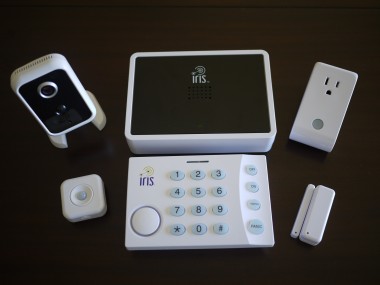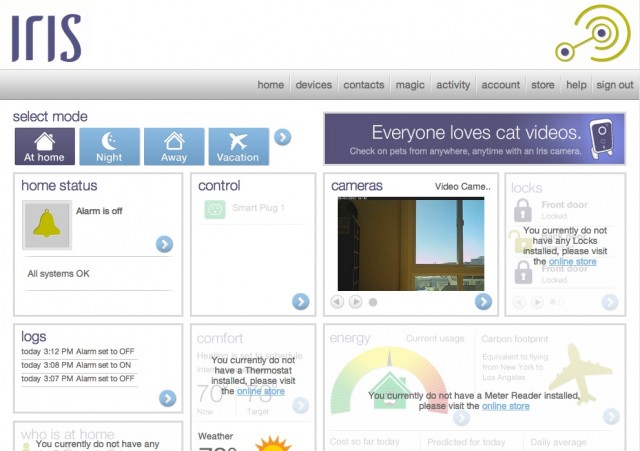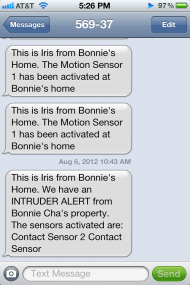Whether you own a house or rent an apartment, protecting your home is important. There are material possessions and mementos of value, of course, but more than that, you want to keep your family safe.
Home-security systems provide some peace of mind, but they can also get pricey, with installation charges and monthly fees. As a budget-friendly alternative, a number of companies have started offering do-it-yourself home-security kits that don’t require expensive monitoring fees. Skylink offers such products, and even Verizon has a foot in the business. Both can save you a couple hundred dollars a year, compared to security outfits such as ADT.
This week, I tested a new entrant by Lowe’s called Iris, based on technology from U.K.-based company AlertMe. Iris allows you to monitor and control your home using your smartphone, tablet or laptop. It’s fairly easy to set up, and gives you some basic services at no additional cost, such as a text or email alert when an alarm is triggered. But I found in my testing that it’s not suitable for all homes, and has limited customer support — for now.
Iris comes in three different kits. The Iris Safe & Secure package costs $179 and includes motion and contact sensors for your doors, windows and cabinets, as well as an Iris Hub and a keypad. The Iris Comfort & Control kit is also $179, and comes with a thermostat and smart plugs for remotely controlling devices, such as lamps, inside the house. (Though not security focused, you can use the smart plugs to turn on lamps while you’re away, to simulate someone being home). Finally, the Iris Smart Kit combines the contents of both packages, and costs $299. You can also buy additional accessories.
Included with the purchase of a kit is two free months of Iris’s premium service, which alerts up to six people when an alarm is triggered, allows you to schedule when a device is turned on or off and offers up to 10 minutes of video streaming if you have a camera set up in the house. After the trial is up, the service costs $10 per month, or you can go with the free basic service that sends notifications to one contact, and provides up to two minutes of video streaming on your smartphone or computer.
I checked out the Safe & Secure kit with the addition of a smart plug and wireless camera, which costs about $340 in total. Before you start installation, you have to register on the Iris Web site; it will then walk you through each step. Setting everything up is pretty straightforward, and took me about an hour.
The Iris Hub is a medium-size set-top box that acts as the mission-control center and connects to your wireless router via an Ethernet cable, so you need a router that has more than one Ethernet port. If you opt for the wireless camera, it, too, requires a connection to the router for initial setup. Everything else connects to the hub wirelessly.
As soon as I inserted the included batteries into the keypad and sensors, they connected to the hub within a matter of seconds. I decided to put the motion sensor in my front hallway, at about chest level. Lowe’s cautions that a change in temperature and pets can trigger the alarm, so it’s best to place the sensor higher up and away from vents.
I placed one contact sensor on my front door, and one on a sliding window near the fire escape. But the latter proved to be a problem.
The sensors consist of two separate pieces, which communicate with each other to signal when a door or window is open or closed. In order to do so, they must be no more than a quarter of an inch apart. There was a slight gap when I adhered the sensor to the window frame and the window. As such, Iris kept identifying the window as open, and sent alerts whenever I had the alarm on.
I couldn’t find a workaround for this, and since all my windows are similar, I gave up and placed the remaining sensor on my back door.
Once you have everything set up, you can manage your system from the Iris Web site. By default, Iris is set to send you text and email alerts when one of the sensors is triggered when the alarm is on or in partial mode. But this isn’t immediately clear, as the alarm settings are buried under several different menus.
Instead, I thought you had to activate this feature through the Magic tab, but by doing so, I set the system to send me notifications even when the alarm was off. Every time I passed by the motion sensor, my phone would start buzzing and ringing, which drove me crazy.
What’s worse is that customer support is minimal at this time. Though the company has a pretty decent FAQ section and video tutorials, it didn’t address the issue I had, and the customer-support line has limited hours. I wasn’t able to reach them at all over the weekend. For a DIY product like Iris, I think it’s crucial to have excellent technical support. Lowe’s told me it is expanding its support offerings soon.
After I got everything sorted out, Iris worked great. I had a friend “break in” while I waited outside, and I received an intruder alert via text and email, noting which sensors had been triggered. Iris leaves it up to the customer to decide whether to call emergency services, since most alarms turn out to be false.
I also found the mobile companion app — which is available for the iPhone, iPod, iPad and Android devices — to be helpful in turning off the alarm before entering the house, viewing video and controlling devices remotely.
If you’re looking for an affordable home-monitoring system, Iris certainly fits the bill, and installation is easy enough that you can do it yourself. But given the design limitations of the contact sensors, I can’t recommend Iris for every home. Like a lot of home-improvement projects, it pays to take the time to figure out where you want to place the alarms before deciding if Iris is the right system for you.




This movie thoroughly explored rape in every sense of the word. Melbourne CCTV Installers
Trả lờiXóa